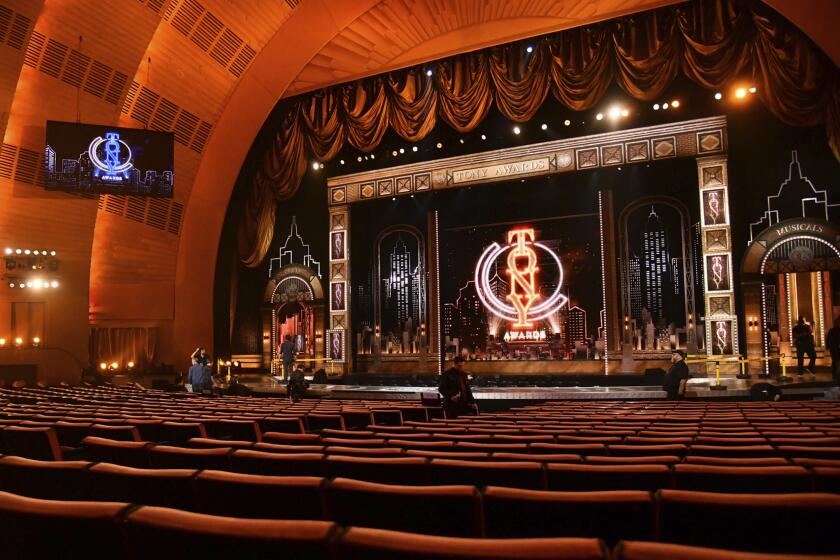Finnish-Born Artist Rejects ‘Eccentric’ Label : Sculptor Carves His Niche at Mountain Retreat
- Share via
Although he has worked for 17 years in a shed in the mountains near Agoura Hills, the sculptor Eino says he rarely feels either bored or isolated.
“I am far too busy for that,” the Finnish-born marble worker said when a stranger climbed a fence to interrupt him recently. “People seem to love labels, like ‘hermit’ or ‘recluse.’ I have been called a wild man, but it isn’t really true. I consider myself to be healthy. I am doing what I want to do.”
What Eino does, at 45, is sculpt. Working out of a battered shed off the Mulholland Highway north of Kanan Road, he has spent the bulk of his professional career shaping marble stones into artworks, which in turn have found their way to collections across the world.
In art catalogues, he is listed simply as Eino, born 1940, in Helsinki. His legal last name--Romppanen--has been all but abandoned in favor of the signature he carves into his work.
Artworks Scattered
The rewards of 23 years of this labor are scattered over the world. Institutional customers include the Finnish Olympic Committee, the Library of Congress and the city of Osaka, Japan. Collective exhibits have been organized by Pepperdine University, the national Endowment for the Arts and the California Institute of Technology.
The work, for the most part, has been shaped in or near a ramshackle, tin-and-wood shed that looks as if it had been dropped from a plane. Surrounded by a whitish dust produced during the nearly two decades Eino has spent sculpting, the retreat has served as an office for the artist and a storehouse for his work.
Although a stranger might find Eino’s life style eccentric, the artist says it is not that way at all.
“If you were to do this in Europe you would be like a lawyer, or a doctor,” said the gaunt, weathered sculptor, who is also a fervent vegetarian and long-distance runner. “But here you are thought of as weird. How strange. . . . “
Former Munitions Expert
The work dates to the late 1950s, when Eino worked as a munitions expert in the Finnish equivalent of the Corps of Engineers. While others studied either explosions or explosives, Eino became intrigued with the wreckage, particularly when it involved rock formations.
That fascination became an obsession in 1962, shortly after Eino moved to Southern California to study science at Santa Monica College. After briefly studying psychiatry, he dropped his classes and re-registered as an art student.
From the beginning, he worked mostly with marble, the chosen stone of sculptors since Michelangelo.
But, by 1968, Eino had offended more than his share of landlords in Venice and Santa Monica, by virtue of the noise he made with his chisels and pneumatic tools. To avoid offending neighbors, he moved his studio to an isolated tract off the Mulholland Highway in the Santa Monica Mountains.
He has worked there ever since. Today, in fact, the site resembles more of a homestead than a studio, with a small house, a slew of animals and an aging, stand-up swimming pool. The animals include four dogs, two donkeys and a talking raven aptly named Lenore.
Years of Creative Labor
The studio itself, set between the house and the road, is surrounded by evidence of years of creative labor. An aging trailer with a customized crane sits to one side, near the latest in a series of secondhand air compressors. A broken-down motor sits in the back, in the midst of a pile of tires and cutting machines.
Eino can typically be found at the center of the studio, encased in a set of soundproof radio headphones. Working with everything from dental picks to freeway cutting saws, he puts in an average of six hours daily, shaping the latest of his works.
The stones arrive at the shack by a variety of means. Occasionally, Eino will travel with his trailer to mountainous areas in Mexico and California, collecting marble samples and hauling them slowly home. He also keeps in close touch with marble quarriers in Italy and Portugal, who call when something striking turns up.
Shaped in Three Phases
Working from tiny sketches, or what he says are “exact” mental pictures, Eino generally shapes the marble in three phases. Larger drills and saws are used to cut a raw form, whereas smaller tools shape and cut the details. The third stage is refining and polishing.
Since the marble pieces are generally huge to begin with--the most recent piece, shipped from Italy, weighed 50,000 pounds--a single sculpture is often years in the making. Most of those years, by Eino’s account, consist largely of “an incredible amount of boring, difficult, physical work.”
The largest collection of Eino’s work remains near his shack in the mountains. Roughly 20 of the sculptures are on display there, ranging wildly in size and shape. Among the largest is a seven-foot needle called “Inspiration,” from 1970; among the smallest is a bronze bust of Olympian Frank Shorter from 1980.
Over the years, Eino said, his works have tended to grow larger and progressively more abstract. Except for occasional commission work, he stopped carving human forms in 1969, moving toward what he calls “an effort to carve space.” His artistic goals include the creation of a enormous sculpture called “Womb,” designed to be climbed into.
The personal goals are more simply expressed.
“My major goal is to keep working,” he said. “After all this time there is something there that I still don’t understand. Maybe I am living in a dream, yes. But I find it amazing.”
More to Read
The biggest entertainment stories
Get our big stories about Hollywood, film, television, music, arts, culture and more right in your inbox as soon as they publish.
You may occasionally receive promotional content from the Los Angeles Times.










